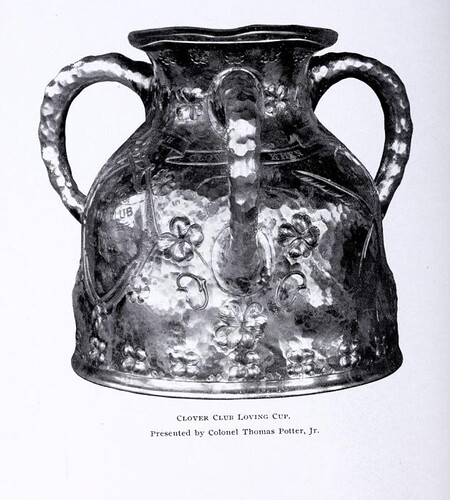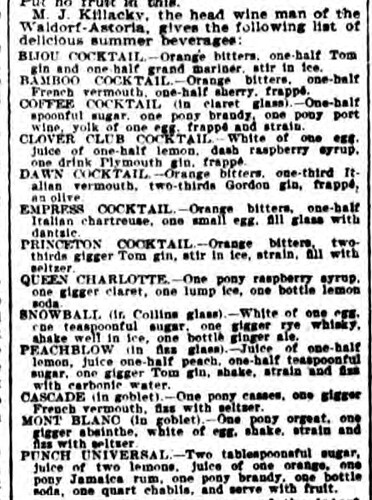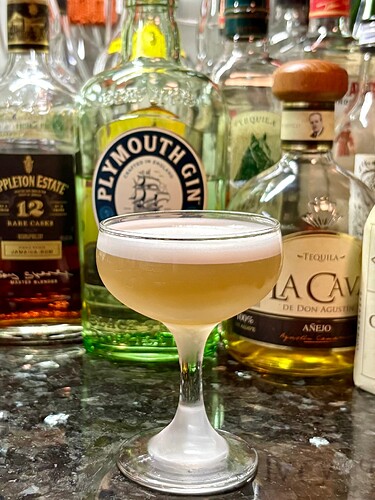Hi everyone,
I haven’t speculated further yet, as I wanted to read the newspaper article mentioning M.J. Killacky first to get clarity on what exactly it says. Thank you, @Splificator, for sharing. It’s wonderful that there’s a recipe in there.
As stated on page 113 of source [1], the first meeting took place in 1880 as the »Thursday Club.« [1-113] The Clover Club was then founded in 1882. [2-13] The book on the history of the Clover Club from 1882 to 1897 states that all Clover Club dinners from 1883 to 1897, with two exceptions, took place at the Bellevue Hotel in Philadelphia. [1-125] This book also contains an illustration of this hotel on page 174 with the caption: »Clover Club House. Hotel Bellevue, Philadelphia« [1-174]
The obituary for George Boldt states: »He then went to Philadelphia, where he found employment at the Clover Club and became a steward there. He earned the esteem of some club members, who later provided the funds for the construction of the old Bellevue.« [4] This statement is also consistent with the caption of [1-174], which confidently states that the club and hotel are practically identical.
This hotel must have already existed in 1882, when the club was founded, because that is where the dinners took place in 1882, starting on April 13. In January and February, they were held at Girard House, and in March at Augustin’s. [1-125] We are probably correct in assuming that the old Bellevue was operational from April 1882 onwards.
Now to @martin’s statement: »As for the drink, given that it isn’t ever mentioned prior to 1901, it seems equally possible that it dates to not much earlier than that. Presumably, the Clover Club was still active and meeting somewhere, possibly still at the old Bellevue Hotel. Then there’s the whole mess with the “Clover Leaf” and the apparent lack of other evidence to tie the damn drink to the Philadelphia Clover Club.«
Another indication that the drink originated later is that [1] contains numerous menus with the sequence of dishes, as well as the drinks served, such as the “Shamrock Punch, à la Chartreuse” [1-171] on March 17, 1892, or the “Clover Punch” on March 15, 1894. [1-171] However, the book does not mention a Clover Club Cocktail or Clover Leaf Cocktail. If this mixed drink had already existed as a “house drink” at that time, wouldn’t it have been included in this detailed book? @CurrerBachman also seems to share this doubt.
@Splificator also seems to have his doubts, writing, »I’d be surprised if the cocktail was older than, say, 1897. But then again, I’m often surprised, and who knows what secrets the archives are still holding onto.«
One thing is still bothering me, and maybe one of you has an answer? Wikipedia writes [3] about George Boldt, who was hired in 1876 by »William Kehrer, steward of The Philadelphia Club, as his assistant steward«. Shortly thereafter, he married his daughter. »Prominent members of the Philadelphia Club assisted the couple in setting up their own hotel, the Bellevue.« So the Belevue was his hotel. But why does it say “Philadelphia Club” here and not “Clover Club”? That contradicts the obituary. And if you follow the link to the Wikipedia article on the Philadelphia Club, [5] it becomes clear that this was a completely different club. An error on Wikipedia?
Like @martin, I would also like to know what happened to the old Bellevue. Until when did the Clover Club meet there?
So, what does all this tell us? We know that in 1901, the Clover Club was well known at the Waldorf-Astoria. There is much to suggest that it originated around or shortly before 1900. At that time, however, George Boldt was no longer in Philadelphia, but had been the owner of the Waldorf-Astoria since 1890 (or shortly thereafter) and was therefore in New York. [6] It is therefore pure speculation whether Michael Killackey received the recipe for the Clover Club from George Boldt, or via his channels to Philadelphia, or whether it might even have originated at the Waldorf-Astoria. I consider both possibilities to be feasible, even though there is much to suggest that it originated in Philadelphia, as newspaper articles from subsequent years suggest. But the recipe could just as easily have made its way from New York to Philadelphia, only to be imported back a few years later as something new. Without clear evidence, we will probably never know.
Well, with this recipe from 1901, I see that I need to re-examine my recipe at https://bar-vademecum.de/clover-leaf-cocktail-a-k-a-clover-club-cocktail/. I suspect that I am using far too much citrus juice and raspberry syrup. The taste will decide whether less of these ingredients should be used. The juice of half a lemon at that time was probably equivalent to a maximum of 15 ml; I’d say rather less.
[1] https://archive.org/details/cloverclubofphil00deac/page/112/mode/2up?q=thursday Mary R. Deacon: The Clover club of Philadelphia. Philadelphia, 1897.
[2] https://archive.org/details/cloverleavescomm00clov/page/12/mode/2up The Clover Club: Clover Leaves. A commemorative volume. Philadelphia, 1885.
[3] https://en.wikipedia.org/wiki/The_Bellevue-Stratford_Hotel#George_Boldt The Bellevue-Stratford Hotel / George Boldt .
[4] https://timesmachine.nytimes.com/timesmachine/1916/12/06/104696332.pdf The New York Times, 6 December 1916.
[5] https://en.wikipedia.org/wiki/Philadelphia_Club Philadelphia Club
[6] https://en.wikipedia.org/wiki/George_Boldt George Boldt


